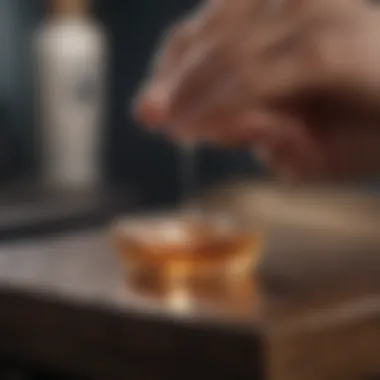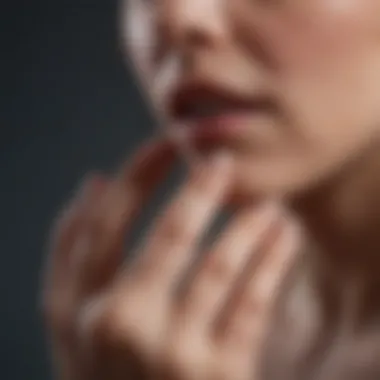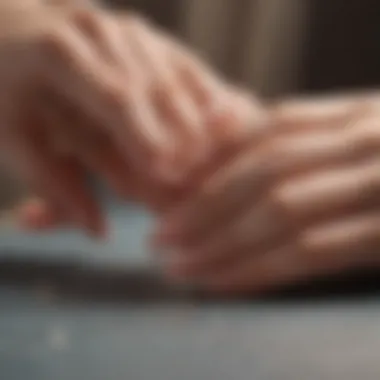A Comprehensive Guide to Soaking Off Nails at Home


Intro
In recent years, at-home nail care has gained significant popularity. Many people prefer the convenience of maintaining their nails without visiting a salon. This trend has led to an increase in DIY techniques for soaking off nails. While removing polish or enhancements can be straightforward, it is crucial to understand the correct methods to prevent damage. This guide aims to help you navigate the ins and outs of removing nails safely and effectively at home, while also maintaining the integrity of your natural nails.
The importance of using proper techniques cannot be overstated. Incorrect removal can lead to weakened nails, infections, or other complications. Knowing the right tools and methods will not only enhance your nail care routine but also promote healthier nails in the long term.
This comprehensive guide will cover key aspects, including essential tools, effective soaking techniques, potential challenges, and solutions to ensure nail health. Whether you are a novice or experienced in nail care, this article serves to refine your approach, helping you achieve the perfect balance between convenience and nail integrity.
Preface to Nail Care
Proper nail care is essential for more than just aesthetics. Beautiful nails can enhance your overall appearance, but there is much more to consider. Understanding nail health is crucial for maintaining their integrity, strength, and appearance. A structured approach to nail care not only ensures that they look good but also prevents various nail conditions that can arise from neglect.
Understanding Nail Health
Nails are composed of keratin, a protein that also forms hair and skin. Healthy nails should be smooth, without grooves or spots. Pinkish hues indicate good circulation, while discoloration may signal underlying health issues. Dry, brittle nails can indicate dehydration or a lack of essential vitamins. Adopting a proactive stance on nail health can help avoid painful conditions and support the natural qualities of your nails.
Regular care includes cleaning and moisturizing cuticles, avoiding harsh chemicals, and maintaining a balanced diet rich in vitamins and minerals. It is also essential to be thoughtful about the products you use, especially when applying enhancements like gels or acrylics.
Concept of Soaking Off Nails
Soaking off nails refers to the method of removing artificial nail products by soaking them in a solution that breaks down their adhesive properties. This technique is significant because improper removal can lead to nail damage, such as thinning or peeling. Soaking allows for a more gradual and gentle removal process, minimizing the risk of harming the natural nail bed. The chosen removers can vary, with acetone being a common choice, though alternatives exist for those sensitive to strong solvents.
Learning the art of properly soaking off nails at home can be a valuable skill. It saves both time and money, as well as provides a greater sense of control over your nail care routine. By understanding both nail health and the soaking process, individuals can maintain their nails in optimal condition while enjoying their appearance.
Types of Nail Products
Understanding the different types of nail products is essential for anyone looking to soak off nails at home. Each category of nail enhancement offers unique benefits and challenges. Recognizing these factors helps in selecting the appropriate soaking method and tools. This section will outline three popular types of nail products: gel nails, acrylic nails, and dip powder nails.
Gel Nails
Gel nails are made from a liquid gel that is cured under a UV or LED light, creating a durable and glossy finish. They are known for their flexibility, which makes them less prone to chipping compared to traditional nail polish. However, removing gel nails requires careful handling, as improper techniques can lead to nail damage.
When soaking off gel nails, acetone is commonly used due to its effectiveness in dissolving the gel formula. Users should be aware that soaking time varies; typically, it takes around 10 to 15 minutes. If gel nails are thickly applied, more soak time might be required.
Acrylic Nails
Acrylic nails consist of a combination of a liquid monomer and a powder polymer. This mixture creates a hard layer when applied, making acrylic nails one of the most popular options for added length or durability. They can be sculpted into various shapes and offer a strong hold. Despite their advantages, acrylic nails can cause significant damage during removal if proper practices are not followed.
The soaking-off process for acrylics is more complex than for gel nails due to their rigidity. It is crucial to utilize acetone as this solvent penetrates through layers effectively. The duration remains similar, around 20 to 30 minutes, although additional scraping may be necessary to remove remaining product. Care should be taken to avoid excessive scraping, which can harm the natural nail underneath.
Dip Powder Nails
Dip powder nails are a hybrid approach, using a bonding solution and colored powders. This system provides a strong finish while requiring less time to apply than gel or acrylic. They boast a lightweight feel and a long-lasting shine. Removal can prove challenging, however, if one is unfamiliar with the process.
Soaking off dip powder nails typically requires a minimum of 15 minutes in acetone. The process can be straightforward, but residual powder can bind to the nail, necessitating gentle scraping with either a nail file or buffer post-soak. It is crucial to be gentle to maintain the integrity of the natural nail.
Through a comprehensive understanding of these products, users can make informed decisions on the best soaking-off methods and tools. This knowledge is essential in maintaining nail health while exploring personal style.


Preparing for Nail Soaking
Preparing for nail soaking is a critical step that often gets overlooked. This stage sets the foundation for a successful removal process. Taking the time to gather the right tools, create a comfortable setting, and understand the methods can significantly enhance the experience. By doing this right, you minimize the risks of damage and optimize nail health.
Essential Tools and Supplies
Acetone or Non-Acetone Remover
Acetone is commonly used for soaking off nails due to its strong solvent properties. It effectively breaks down nail products like acrylic, gel, or dip powder. The key characteristic of acetone is its effectiveness; it requires a shorter soaking time compared to non-acetone alternatives. However, while acetone is efficient, it can be drying to the skin and nails, which is where non-acetone removers come in. Non-acetone options tend to be milder, making them a favorable choice for sensitive skin. They take longer to work, though, which can be a disadvantage. Overall, the choice between them often depends on nail type and sensitivity.
Cotton Balls or Pads
Cotton balls or pads play an integral role during the removal process. They are used to hold the acetone or non-acetone remover against the nails, facilitating the dissolving of the product. Their key characteristic is absorbency; they hold the remover well without falling apart. This makes them a practical choice because they effectively cover the entire nail. However, cotton can sometimes leave behind fibers, which may be an annoyance when trying to achieve a clean finish.
Aluminum Foil
Aluminum foil is essential for wrapping soaked cotton balls around nails. Its reflective surface helps to retain heat, which can accelerate the dissolving process. The unique feature of aluminum foil is its ability to conform to the fingers, creating a snug fit and minimizing evaporation of the remover. Its lightweight nature and bendability make it ideal for this use. A potential downside is that it can be challenging to manage if too small a piece is used, leading to a less effective wrap.
Nail File
A nail file is necessary not just for initial shaping but also for the soaking process. It can help in gently roughening the surface of the nails, which allows for better absorption of removers. The key characteristic here is versatility; nail files come in various grit options, catering to different needs. When using a nail file before soaking, one must be cautious to avoid excessive buffing, as this can weaken the nail structure. Thus, selecting the right grit is essential.
Nail Buffer
Including a nail buffer in your toolkit can serve multiple purposes. It is beneficial for smoothing the nail surface after soaking. This tool helps to remove any remaining residue and ensures the nails are refined. The unique feature of a nail buffer is its gentle polishing action, which can enhance the overall appearance of nails. However, overuse can lead to thinning of the nail layer, which is something to be careful about.
Creating a Comfortable Environment
The environment in which you soak your nails is equally important. A well-prepared space can improve focus and relaxation. Begin by choosing a quiet area where interruptions are minimal. Comfortable seating can make the process more enjoyable. Additionally, having proper lighting will help in monitoring the soaking process and ensure you can see what you are doing clearly. Organizing all supplies beforehand reduces stress during the actual removal, making it a smoother experience overall. Note that taking breaks during soaking can also help manage any discomfort, so consider keeping a timer for the process.
Step-by-Step Process of Soaking Off Nails
In this part of the guide, the main focus is to elucidate the process of soaking off nails. This practice is vital for maintaining nail health and ensuring an effective removal of products without causing harm. Each step must be undertaken with care and precision. A systematic approach not only enhances safety but also minimizes the risk of nail damage. Understanding this process helps both novices and experienced individuals achieve a successful outcome while fostering a healthy nail care routine.
Preparation of Nails
Before the soaking begins, proper preparation of the nails is essential. This stage sets the foundation for a smooth removal process. Start by trimming the nails to a manageable length, helping to avoid excessive product during the soak. Following this, gently file the surface of the nails, which can assist the remover in penetrating the layers of the product. This step should be performed lightly to prevent unnecessary damage to the natural nail underneath. By taking the time to prepare correctly, you ensure a more effective and pleasant removal experience.
Applying the Soaking Method
Using Acetone
Acetone is a commonly used solvent for removing nails. It works effectively by breaking down the polymers found in gel and acrylic products. Its primary characteristic is its fast-acting nature. This means it often provides quicker results compared to other methods. Its strong solvent power makes it a popular choice among many users. However, while it offers quick results, there are some disadvantages, such as drying out the nails and surrounding skin. Therefore, applying a moisturizer after use is advisable to mitigate dryness.
Using Alternative Removers
On the other hand, alternative removers, such as non-acetone solutions, are available for those concerned about the harsh effects of acetone. These products tend to be gentler on the nails and skin, making them a favourable option for individuals with sensitive skin or those who desire a milder removal process. The key aspect of these alternatives lies in their ability to dissolve the product without the extreme pungency associated with acetone. However, it’s essential to recognize that they may require a longer soaking time to achieve the same results as acetone. Therefore, understanding the balance between effectiveness and gentleness is crucial in selecting the right method for your needs.
Monitoring the Soak Time


Signs of Product Dissolution
During the soaking process, it is important to monitor the signs that indicate the product is dissolving. Look for changes in the texture and appearance of the product. It may begin to bubble or swell, which are good signs that the solvents are doing their job. This stage is pivotal in determining how long to continue the soak. If you miss these indicators, you might end up over-soaking, which can weaken your nails. Monitoring carefully ensures successful removal while safeguarding nail integrity.
Recommended Soaking Time
The amount of time to soak nails is another critical factor. Generally, a soaking time of 10 to 15 minutes is recommended, though this can vary based on the type of product used. For example, gel nails often require longer soaking times than standard nail polish. It is essential not to exceed the recommended duration too much, as prolonged exposure can lead to nail brittleness or damage. Setting a timer can help keep track of the soaking duration. The goal is to strike a balance between effective removal and maintaining healthy nails.
Post-Soaking Care
Post-soaking care is a critical aspect of maintaining nail health after the removal of nail products, such as gels or acrylics. Once the soaking process is completed, the nails may become vulnerable due to exposure to harsh chemicals that can lead to dryness or even damage. Therefore, it is essential to take specific steps to ensure that the integrity of the nails is preserved and that proper recovery is facilitated.
Effective post-soaking care can help rejuvenate the nails and cuticles, restoring their natural strength and appearance. Addressing these needs directly impacts long-term nail health. By focusing on both removing any residual product effectively and employing recovery techniques, you can support your nails as they return to their natural state and enhance their resilience.
Removing Residue Effectively
After soaking off the nails, there may still be some residue left behind. It is crucial to remove this effectively to prevent any long-term damage. Using a gentle yet effective nail file can help smooth out any uneven edges or stubborn areas that haven’t fully dissolved. Ensure to apply gentle pressure; aggressive filing can lead to further thinning of the nail.
Additionally, if any product remains after the soaking, you can try to soak a bit longer or use a cotton ball soaked in acetone. Gently rub the area until all residue comes off. This step is vital because any residue left on the nails can hinder their ability to recover properly.
Nail Recovery Techniques
Post-soaking nail recovery techniques are essential to maintain healthy nails moving forward. Focusing on strengthening and moisturizing the nails and cuticles plays a significant role in recovery.
Nail Strengthening Treatments
Nail strengthening treatments are designed to enhance the durability and resilience of nails after a product removal process. These treatments often contain proteins and vitamins that support nail growth. They are popular choices because they target weakness and potential brittleness directly.
A key characteristic of these treatments is their ability to create a protective barrier on the nail surface. This barrier prevents environmental damage and doubles as a conditioner for the nail plate. Many users find that consistent application leads to noticeable improvements in nail strength over time.
However, one disadvantage is that some products may contain chemicals that could irritate sensitive skin or nails. Thus, it is crucial to choose high-quality, hypoallergenic products that align with your specific nail type and sensitivity.
Moisturizing Cuticles
Moisturizing cuticles is another critical aspect of post-soaking care. After the removal of nail products, cuticles can often become dry and prone to peeling. Regularly moisturizing the cuticles helps maintain their health and integrity around the nail bed, promoting overall nail growth.
The key characteristic of moisturizing cuticle treatments is their hydrating properties which soothe the skin and prevent dryness. Products like cuticle oils or creams are ideal, often infused with essential oils that not only hydrate but also provide nourishment to both the cuticles and the nails.
While moisturizing cuticles offers many benefits, including preventing hangnails and promoting nail growth, it is important to select products that do not leave a greasy residue. Non-greasy formulations allow for daily use without overwhelming the touch of other tasks you may encounter.
Common Challenges and Solutions
When it comes to soaking off nails at home, it is crucial to understand the various challenges that can arise during the process. Addressing these challenges ensures not only a successful removal but also the integrity of the natural nails following the soak. Each method of nail application, whether gel, acrylic, or dip powder, presents unique issues. Knowing how to confront these common problems can make your home nail care experience more enjoyable and effective.
Dealing with Stubborn Products
Stubborn nail products don't dissolve easily, which can cause frustration. Gel nails and certain acrylics often resist the soaking process. When faced with a stubborn product, a few strategies can be utilized:


- Extended Soaking Time: Sometimes, the soaking time may need adjustment. Instead of the usual 10-15 minutes, extending it can help break down tougher formulas.
- Soaking Agents: Consider using a higher concentration of acetone or a specialized gel remover. These have stronger solvents that target stubborn bonds more effectively.
Often, failure to remove stubborn products stems from insufficient moisture absorption. Make sure the cotton balls or pads are fully saturated in the solvent; they should not be dry at any point.
Avoiding Damage During Removal
It is vital to proceed with care to prevent damage to the natural nail bed. Aggressive scraping or filing can lead to thinning or splitting of nails. Here are some preventive measures:
- Gentle Scraping: Use an orange stick or a rubber-cuticle pusher. This is a safer option to gently nudge the product off without damaging the nail surface.
- Limit Filer Use: Avoid using a nail file too extensively. If filing is necessary, opt for a fine-grit buffer to smoothen slight imperfections without harsh pressure.
- Moisturize: Post-removal, apply cuticle oil to hydrate the nail bed. This not only aids in recovery but also maintains nail moisture, reducing the risk of brittleness.
Nail damage can be minimized by using gentler techniques, ensuring your natural nails stay healthy for future applications.
Addressing Nail Thickness and Weakness
Some individuals may notice that their nails feel thinner or weaker after certain soaking processes. This can occur due to exposure to harsh chemicals during application and removal. To help combat this:
- Strengthening Treatments: Incorporate treatments designed to improve nail strength. Products like OPI Nail Envy or Sally Hansen Miracle Cure can be beneficial.
- Regular Moisturization: Consistently moisturizing cuticles and nails helps maintain their health. Look for oils enriched with vitamins and nutrients.
- Limit Soaking Frequency: Allowing adequate time between applications can aid in recovery. This helps in maintaining the health and strength of the nails in the long run.
In summary, understanding and tackling these common challenges are essential for anyone soaking off nails at home. Approaching the process with care and the right techniques can enhance the experience and preserve natural nail health.
Preventive Measures for Future Use
Preventive measures are crucial in nail care, especially when it comes to soaking off nails at home. Implementing effective strategies can significantly reduce the risk of nail damage and improve overall nail health. Understanding preventive measures allows individuals to maintain the aesthetic quality of their nails while ensuring their integrity. This section will discuss two key components: the importance of selecting quality products and the necessity of adopting safe application techniques.
Choosing Quality Products
When dealing with nail enhancements, the quality of products plays a pivotal role in preventing future issues. Quality nail products tend to have better formulations, which translates to less damage during removal. Low-quality products may contain harmful chemicals that can weaken nails over time. Choosing reputable brands minimizes risks and promotes healthier nails. Look for products that are free from harsh ingredients like formaldehyde and toluene.
In addition, read reviews before purchasing. Feedback from other users can provide insight into product performance. Investing in high-quality nail removers can ease the soaking process. This leads not only to effective removal but also to reduced long-term consequences on nail health. For instance, using brands like OPI or Sally Hansen has proven beneficial for many individuals.
Adopting Safe Application Techniques
Adopting safe application techniques is fundamental in preserving nail integrity. Many users overlook the significance of proper methods, which can result in nail damage or infection. Always ensure that nails are clean before applying any product. This practice helps to avoid any potential contamination.
When using soaking methods, ensure that the soaking time is appropriate. As mentioned earlier in the article, excessive soaking can weaken nails. It is also advisable to refrain from forcefully scraping the product off. Instead, allow the products to dissolve naturally. Here are some techniques that can enhance safety:
- Use cotton balls saturated with remover: This allows for a uniform application.
- Wrap fingers if necessary: Aluminum foil can add extra moisture, aiding in faster removal without damaging the nail.
- Keep nail tools sanitized: This prevents the risk of infections.
By combining quality product choices with safe techniques, individuals can greatly enhance their nail care practices.
Epilogue
In this article, we have explored the essential aspects of soaking off nails at home. The conclusion serves as a summary, emphasizing the importance of following proper techniques and using the right tools during this process. Neglecting these elements can lead to nail damage, which is counterproductive to one of the primary goals of nail care: maintaining health and integrity.
Additionally, the discussion of various nail product types—such as gel, acrylic, and dip powder—illustrates that the removal methods must meet the specific characteristics of each product. This guide also emphasizes the significance of creating a comfortable environment and post-soaking care. These factors contribute to a more successful and less stressful nail removal experience.
The content provided here benefits a range of audiences, from beginners to seasoned nail enthusiasts. It addresses common challenges faced while soaking off nails, offering practical solutions to avoid damaging the nails during the process. The emphasis remains on preventing issues that could arise during nail care routines.
By integrating the knowledge and techniques discussed in this article into daily practices, readers can achieve healthier nails while improving their overall nail care routine in a meaningful way. Understanding the strategies shared within this guide enhances proficiency in personal nail care.
Final Thoughts on Nail Care
Nail care is an ongoing process that requires attention and commitment. A proper approach can lead to improved nail health and aesthetics. This means regularly assessing nail conditions and adjusting care routines as needed.
The necessity of choosing quality products cannot be overstated. Many low-quality nail products can round in long-term damage. Opting for reputable brands is advantageous. Likewise, adopting safe application techniques when applying newer nail products, such as gels and acrylics, is crucial.



